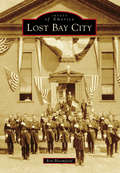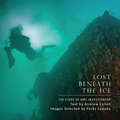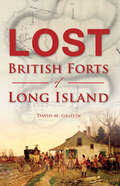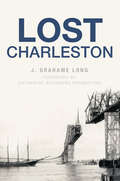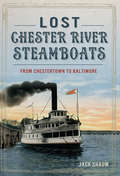- Table View
- List View
Lost Battalions: The Great War and the Crisis of American Nationality
by Richard Slotkin"A work of stunning density and penetrating analysis . . . Lost Battalions deploys a narrative symmetry of gratifying complexity."—David Levering Lewis, The NationDuring the bloodiest days of World War I, no soldiers served more valiantly than the African American troops of the 369th Infantry—the fabled Harlem Hellfighters—and the legendary 77th "lost battalion" composed of New York City immigrants. Though these men had lived up to their side of the bargain as loyal American soldiers, the country to which they returned solidified laws and patterns of social behavior that had stigmatized them as second-class citizens.Richard Slotkin takes the pulse of a nation struggling with social inequality during a decisive historical moment, juxtaposing social commentary with battle scenes that display the bravery and solidarity of these men. Enduring grueling maneuvers, and the loss of so many of their brethren, the soldiers in the lost battalions were forever bound by their wartime experience. Both a riveting combat narrative and a brilliant social history, Lost Battalions delivers a richly detailed account of the fierce fight for equality in the shadow of a foreign war.
Lost Battlefields of Britain
by Martin HackettThe British Isles have witnessed hundreds of battles, both great and small, in their two thousand years of recorded history, but not all are widely remembered today. Many of these battles are well known, due to their far-reaching consequences, their sheer scale or the involvement of famous protagonists. Even so, many battles have never been properly investigated, perhaps because their importance was never understood or because they have never been included in previous books on British battlefields.In this book, Martin Hackett examines ten forgotten British battles, covering the length and breadth of Britain and some 900 years of warfare. For each, he provides a concise account of the battle itself and analyses its military, archaeological and political significance. Each entry is accompanied by current photographs of the location, a modern map of the battlefield with suggested tours and information on exploring the site today.
Lost Bay City
by Ron BloomfieldWhen the phrase "Do you remember?" is uttered in Bay City, it is usually followed by the name of a hotel, restaurant, business, or building. Slowly, many parts of local history have been lost to the sands of time. Fire took many, followed by condemnations and the inevitable advance of progress. An empty lot may be all that remains of a once-prominent structure, but sometimes a new landmark emerges. In the case of one famous address at Center and Water Streets, the Wenonah Hotel rose out of the ashes of the Fraser House, another prominent facade. Seven decades later, the Wenonah, too, succumbed to fire; out of those ashes rose the Delta College Planetarium, a third-generation landmark. Photographs help residents remember, though each person who experienced something firsthand has his or her own distinct connection with these pieces of lost Bay City.
Lost Beneath the Ice: The Story of HMS Investigator
by Andrew CohenThe story of the bold voyage of HMS Investigator and the modern-day discovery of its wreck by Parks Canada’s underwater archaeologists. When Sir John Franklin disappeared in the Arctic in the 1840s, the British Admiralty launched the largest rescue mission in its history. Among the search vessels was HMS Investigator, which left England in 1850 under the command of Captain Robert McClure. While the ambitious McClure never found Franklin, he and his crew did discover the fabled Northwest Passage. Like Franklin’s ships, though, Investigator disappeared in the most remote, bleak and unknown place on Earth. For three winters, its 66 souls were trapped in the unforgiving ice of Mercy Bay. They suffered cold, darkness, starvation, scurvy, boredom, depression and madness. When they were rescued in 1853, Investigator was abandoned. For more than a century and a half, the ship’s fate remained a mystery. Had it been crushed by the ice or swept out to sea? In 2010, Parks Canada sent a team of archaeologists to Mercy Bay to find out. It was a formidable challenge, demanding expertise and patience. There, off the shores of Aulavik National Park, they found Investigator. Lost Beneath the Ice is a tale of endurance, daring, deceit, courage, and irony. It is a story about a tempestuous crew, their mercurial captain, cynical surgeon and kind-hearted missionary. In the end, McClure found fame but lost his ship, some of his crew and much of his honour. Written with elegance and authority, illustrated with archival imagery and startling underwater photographs of Investigator and its artifacts, this is a sensational story of discovery and intrigue in Canada’s Arctic. Andrew Cohen is a best-selling author and award-winning journalist. Among his books are While Canada Slept, a finalist for the Governor General’s Literary Award, The Unfinished Canadian, and Extraordinary Canadians: Lester B. Pearson. He writes a nationally syndicated column for The Ottawa Citizen and comments regularly on CTV. A professor of journalism and international affairs at Carleton University, he is founding president of the Historica-Dominion Institute. He has twice received Queen’s Jubilee Medals.
Lost Biloxi (Lost)
by Edmond BoudreauxBiloxi's beaches and casinos make the city a haven for Gulf Coast tourists. And since it's one of America's oldest communities, local residents have seen many iconic treasures come and go. Before Hurricane Katrina, more than 150 historical structures dotted the area. Of those, 60 were lost to the devastating storm, including the Father Ryan House, built in the early 1840s. In 1969, Hurricane Camille flattened the Baldwin Wood Lighthouse. Other structures like Biloxi City Hall on Main Street faded away with the passage of time, having stood resolute for decades. Author Edmond Boudreaux recalls Biloxi's most significant and cherished landmarks.
Lost Birmingham (Lost)
by Beverly CriderBirmingham has many notable historic landmarks today, but so many more are all but forgotten. The Bangor Cave Casino was once a world-renowned speakeasy. The Thomas Jefferson Hotel featured a zeppelin mooring station, drawing lots of attention from tourists. Other significant sites from the past, such as Hillman Hospital and the buildings on the "Heaviest Corner on Earth," are unknown even to natives now. Local author Beverly Crider presents an intriguing and educational tour through these and more hidden treasures.
Lost Bluegrass: History of a Vanishing Landscape (Lost)
by Ronnie DreistadtThe Bluegrass region has come to define what makes Kentucky a place unlike any other. What began as the homeland of native tribes developed into ideal farmland for early settlers. Development continued as the region evolved into the premier breeding grounds for world-famous thoroughbreds, helping to bring the Bluegrass international recognition as the epicenter of American horseracing and equestrian culture. Yet development of the region has never stopped. The rolling hills, limestone fences and legendary horse farms that once defined the landscape continue to vanish as suburban sprawl stretches into the far reaches of the Bluegrass. Join author Ronnie Dreistadt as he tracks the history of the Bluegrass, what�s been lost and the ongoing efforts to save what remains.
Lost Books of the Bible and the Forgotten Books of Eden
by Thomas NelsonIn Lost Books of the Bible and the Forgotten Books of Eden you can read for yourself many of the manuscripts which were excluded from canonized Scripture and discover new appreciation for those which were chosen.Though apocryphal in nature--many of them suppressed by the early Church Fathers--these forgotten books, gospels, testaments, and epistles are fascinating and beautifully written.Included in this volume are:Apocryphal gospel accounts, such as The Gospel of the Birth of Mary, Thomas's Gospel of the Infancy of Christ, and Peter's Gospel.Apocryphal epistles, such as Paul's letter to the Laodiceans, Clement's letter to the Corinthians, and the general epistles of Barnabas.Letters from Ignatius to groups of early Christians, including the Ephesians, the Romans, and the Trallians.The early 2nd century Christian work, The Shepherd of Hermas.Roman letters and reports from Herod and Pilate.Fables from Old Testament times, such as The Books of Adam and Eve, The Secrets of Enoch, and the Psalms of Solomon.Historical accounts, including the fourth book of the Maccabees.and more...Included before each book are some notes on its origins. Also included are frequent black-and-white images of etchings from early manuscripts.
Lost Boy Found
by Kirsten AlexanderPerfect for fans of the NYT bestseller Sold on a Monday, this Southern historical novel based on the true story of a boy's mysterious disappearance examines despair, loyalty, and the nature of truth. In 1913, on a summer's day at Half Moon Lake, Louisiana, four-year-old Sonny Davenport walks into the woods and never returns. The boy's mysterious disappearance from the family's lake house makes front-page news in their home town of Opelousas. John Henry and Mary Davenport are wealthy and influential, and will do anything to find their son. For two years, the Davenports search across the South, offer increasingly large rewards and struggle not to give in to despair. Then, at the moment when all hope seems lost, the boy is found in the company of a tramp. But is he truly Sonny Davenport? The circumstances of his discovery raise more questions than answers. And when Grace Mill, an unwed farm worker, travels from Alabama to lay claim to the child, newspapers, townsfolk, even the Davenports' own friends, take sides. As the tramp's kidnapping trial begins, and two desperate mothers fight for ownership of the boy, the people of Opelousas discover that truth is more complicated than they'd ever dreamed.
Lost Boy, Lost Girl: Escaping Civil War in Sudan
by John Bul Dau Martha Arual AkechOne of thousands of children who fled strife in southern Sudan, John Bul Dau survived hunger, exhaustion, and violence. His wife, Martha, endured similar hardships. In this memorable book, the two convey the best of African values while relating searing accounts of famine and war. There's warmth as well, in their humorous tales of adapting to American life. For its importance as a primary source, for its inclusion of the rarely told female perspective of Sudan's lost children, for its celebration of human resilience, this is the perfect story to inform and inspire young readers.
Lost Boy: A Prequel Novella to Everland (Everland #1)
by Wendy SpinaleAll children, except one, grow up. Or do they?Find out in this Everland prequel novella . . .Before Captain Hook annihilated England, before the Lost City was built underground, before Gwen stole his heart, Pete was a just boy living among the shadows. Determined to get himself and his sister out the rundown orphanage, Pete finds a solution in the seedy underbelly of London, a deadly place of scamps and thieves where survival is determined by cunning skill and bareknuckle bravery. But then one night, everything changes . . .In this dark reimagining of the original Lost Boy, Wendy Spinale weaves a stunning story of courage and heartbreak, loss and redemption as one boy is forced to face his past . . . and his future.
Lost Boy: The True Story of Captain Hook
by Christina HenryFrom the national bestselling author of Alice comes a familiar story with a dark hook—a tale about Peter Pan and the friend who became his nemesis, a nemesis who may not be the blackhearted villain Peter says he is…There is one version of my story that everyone knows. And then there is the truth. This is how it happened. How I went from being Peter Pan’s first—and favorite—lost boy to his greatest enemy. Peter brought me to his island because there were no rules and no grownups to make us mind. He brought boys from the Other Place to join in the fun, but Peter's idea of fun is sharper than a pirate’s sword. Because it’s never been all fun and games on the island. Our neighbors are pirates and monsters. Our toys are knife and stick and rock—the kinds of playthings that bite.Peter promised we would all be young and happy forever. Peter lies.
Lost Boys
by Darcey RosenblattBased on historical events, this unforgettable and inspiring tale for middle-grade readers is about a young boy torn from the only life he’s ever known and held captive as a prisoner of war.In 1982, twelve-year-old Reza has no interest in joining Iran’s war effort against Iraq. But in the wake of a tragedy and at his mother’s urging, he decides to enlist, assured by the authorities that he will achieve paradise should he die in service to his country. War does not bring the glory the boys of Iran have been promised, and Reza soon finds himself held in a prisoner-of-war camp in Iraq, where the guards not only threaten violence—they act upon it. Will Reza make it out alive? And if he does, will he even have a home to return to?Friendship, heartbreak, and Reza’s very survival are at stake as he finds solace through music and forges his own path—wherever that might take him.
Lost British Forts of Long Island (Lost Ser.)
by David M GriffinAuthor David M. Griffin uncovers the lost history and harrowing stories of Long Island's British forts.When the Revolutionary War broke out and New York City had fallen in 1776, the forces of the king of Great Britain developed a network of forts along the length of Long Island to defend the New York area and create a front to Patriot forces across the Sound in Connecticut. Fort Franklin on Lloyd's Neck became a refugee camp for Loyalists and saw frequent rebel attacks. In Huntington, a sacred burial ground was desecrated, and Fort Golgotha was erected in its place, using tombstones as baking hearths. In Setauket along the northern shore, the Presbyterian church was commandeered and made the central fortified structure of the town.
Lost Burbank (Lost)
by Wesley H. Clark Michael B. McDanielSlowly fading with the city's ever-changing landscape, the places and people of Burbank's past tell a vibrant story. Before the arrival of Warner Bros. and Walt Disney, First National Pictures built its original studio lot on Olive Avenue in 1926. For over sixty years, Lockheed Aircraft Company produced some of the nation's best airplanes where the massive Empire Shopping Center now stands. Heavyweight champion James Jeffries turned his Burbank ranch home and barn into a beloved landmark and boxing venue. And inventor Joseph Wesley Fawkes's scheme to build a monorail to Los Angeles became a local laughingstock. Die-hard Burbankers Wes Clark and Michael McDaniel collect these and many more forgotten local stories where they can finally be found.
Lost Butte, Montana
by Richard I. GibsonFrom the stately Queen Anne mansions of the West Side to the hastily constructed shanties of Cabbage Patch, Lost Butte, Montana traces the city's history through its architectural heritage.This book includes such highlights as the Grand Opera House, once graced by entertainers and cultural icons like Charlie Chaplin, Sarah Bernhardt and Mark Twain; the infamous brothels protested by reformer Carrie Nation, wielding her hatchet and sharp tongue; and the Columbia Gardens, built by copper king William Clark as a respite from the smoke and toil of the mines and later destroyed by fire. Through the stories of these structures, lost to the march of time and urban renewal, historian Richard Gibson recalls the boom and bust of Butte, once a mining metropolis and now part of the largest National Historic Landmark District.
Lost California (Postcard History Series)
by Mr. Erik BeckThe postcards in this collection reflect a hidden past of California that exists now only on the page. From college gates at Stanford destroyed by the 1906 earthquake and hotels in Catalina, Santa Barbara, and Oakland ravaged by fire to giant redwoods on the coast felled by storms and much of downtown Los Angeles razed in the name of the progress, California's landscape has changed dramatically in the last 125 years. The buildings demolished in San Diego's Balboa Park after the 1915 exposition closed are shown here as is downtown San Francisco before the earthquake and fire of 1906, amusement parks that decorated waterfronts from Long Beach to Santa Monica, and city halls from Anaheim to San Jose.
Lost Capitals of Alabama (Lost)
by Herbert James LewisAlabama's capital has roots all over the state. It first emerged in St. Stephens in 1799, a small fort acquired from the Spanish atop a tall limestone bluff overlooking the Tombigbee River. Next came Huntsville in the Tennessee Valley, where the state constitution emerged. Cahawba was the capital to receive a visit from the Marquis de Lafayette, the last surviving general of the American Revolution. In 1826, Tuscaloosa took the reins for twenty years before the final move to Montgomery. Discover the leaders and events that established the state and the fates of each dynamic governmental center as author Jim Lewis traces the history of Alabama's lost capitals.
Lost Car Companies of Detroit (Lost)
by Alan NaldrettAmong more than two hundred auto companies that tried their luck in the Motor City, just three remain: Ford, General Motors and Chrysler. But many of those lost to history have colorful stories worth telling. For instance, J.J. Cole forgot to put brakes in his new auto, so on the first test run, he had to drive it in circles until it ran out of gas. Brothers John and Horace Dodge often trashed saloons during wild evenings but used their great personal wealth to pay for the damage the next day (if they could remember where they had been). David D. Buick went from being the founder of his own leading auto company to working the information desk at the Detroit Board of Trade. Author Alan Naldrett explores these and more tales of automakers who ultimately failed but shaped the industry and designs putting wheels on the road today.
Lost Carson City (Lost)
by Peter B. MiresCarson City has the distinction of being one of the least populated state capitals in the nation, but its contributions to Nevada's history are anything but diminutive. Set against the backdrop of the Sierra Nevada Mountains, it's a quintessential Wild West town. The gold and silver riches of the nearby Comstock Lode left a legacy that includes the Carson City Mint, one of only nine mints ever to exist in the United States, and the Virginia & Truckee Railroad, which still snakes through the hills. Residents once flocked to the Carson Opera House to take in a show and to the local racetrack to bet on the horses. Author Peter B. Mires explores the city's legacies, brick by locally quarried sandstone brick.
Lost Cause (Seven (the Series) #7)
by John WilsonSteve thinks a trip to Europe is out of the question—until he hears his grandfather's will. Suddenly he's off to Spain, armed with only a letter from his grandfather that sends him to a specific address in Barcelona. There he meets a girl named Laia and finds a trunk containing some of his grandfather's possessions, including a journal he kept during the time he fought with the International Brigades in the Spanish Civil War. Steve decides to trace his grandfather's footsteps through Spain, and with Laia's help, he visits the battlefields and ruined towns that shaped his grandfather's young life, and begins to understand the power of history and the transformative nature of passion for a righteous cause. Steve's adventures start in The Missing Skull, part of The Seven Prequels and continue in Broken Arrow, part of The Seven Sequels.
Lost Causes: Confederate Demobilization and the Making of Veteran Identity (Conflicting Worlds: New Dimensions Of The American Civil War Ser.)
by Bradley R. ClampittThis groundbreaking analysis of Confederate demobilization examines the state of mind of Confederate soldiers in the immediate aftermath of war. Having survived severe psychological as well as physical trauma, they now faced the unknown as they headed back home in defeat. Lost Causes analyzes the interlude between soldier and veteran, suggesting that defeat and demobilization actually reinforced Confederate identity as well as public memory of the war and southern resistance to African American civil rights. Intense material shortages and images of the war’s devastation confronted the defeated soldiers-turned-veterans as they returned home to a revolutionized society. Their thoughts upon homecoming turned to immediate economic survival, a radically altered relationship with freedpeople, and life under Yankee rule—all against the backdrop of fearful uncertainty. Bradley R. Clampitt argues that the experiences of returning soldiers helped establish the ideological underpinnings of the Lost Cause and create an identity based upon shared suffering and sacrifice, a pervasive commitment to white supremacy, and an aversion to Federal rule and all things northern. As Lost Causes reveals, most Confederate veterans remained diehard Rebels despite demobilization and the demise of the Confederate States of America.
Lost Cedar Rapids (Lost)
by Peter D. LooneyCedar Rapids is the only city in America to house its government offices on an island. But tons of other iconic structures that defined the city are no longer around. The Little Gallery on First Avenue was created to showcase local artists. Yager's "moved up to bring prices down." The area was home to thirty-nine theaters, including two from 1928 that are still in operation. From the hotels to the factories, the ethnic districts to the depots, the dance halls to the amusement parks, these are the places that made a difference in the City of Five Seasons. Local author Pete Looney traces the history of the structures.
Lost Charleston (Lost)
by J. Grahame LongEven in a city as conscious of history as Charleston, not everything has survived. Natural disasters, wars and other calamities claimed many treasures. Only a few preserved bits of one of the city's grandest mansions survive at Dock Street Theatre. An old Quaker graveyard still rests in peace but does so under a downtown parking garage. The famous corner of Meeting and Broad Streets was once the area's busiest marketplace. The Grace Memorial Bridge spanned the Cooper River for more than seventy years. Author J. Grahame Long details the history of these and more lost locations in the Holy City.
Lost Chester River Steamboats: From Chestertown to Baltimore (Transportation)
by Jack ShaumIn the golden age of the steamer, the rich bounty of the Eastern Shore was transported down the Chester River and across the Chesapeake Bay to the port of Baltimore. For over one hundred years, vessels like the Maryland, the Chester and the B.S. Ford traversed these winding waters laden with fruit, grains, crabs and oysters. For a dollar, passengers could enjoy the novelty of a ride and the slow panorama of the shoreline. Through freeze and fog, skilled captains plied the waterways until the last of the steamers--the Bay Belle--made its final passage in the 1950s. Author and historian Jack Shaum journeys back to the bygone days of the Chester River's steamboats.


